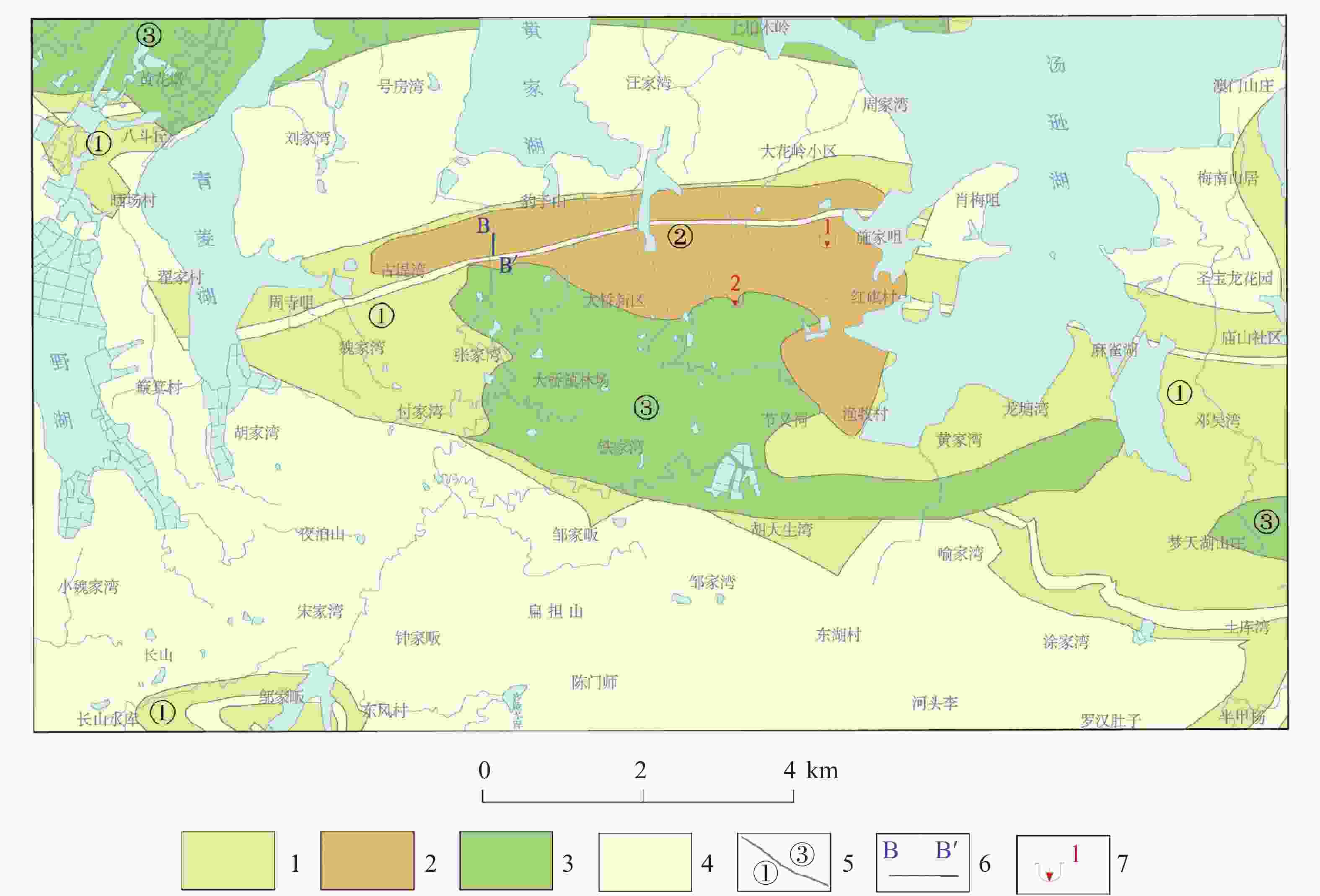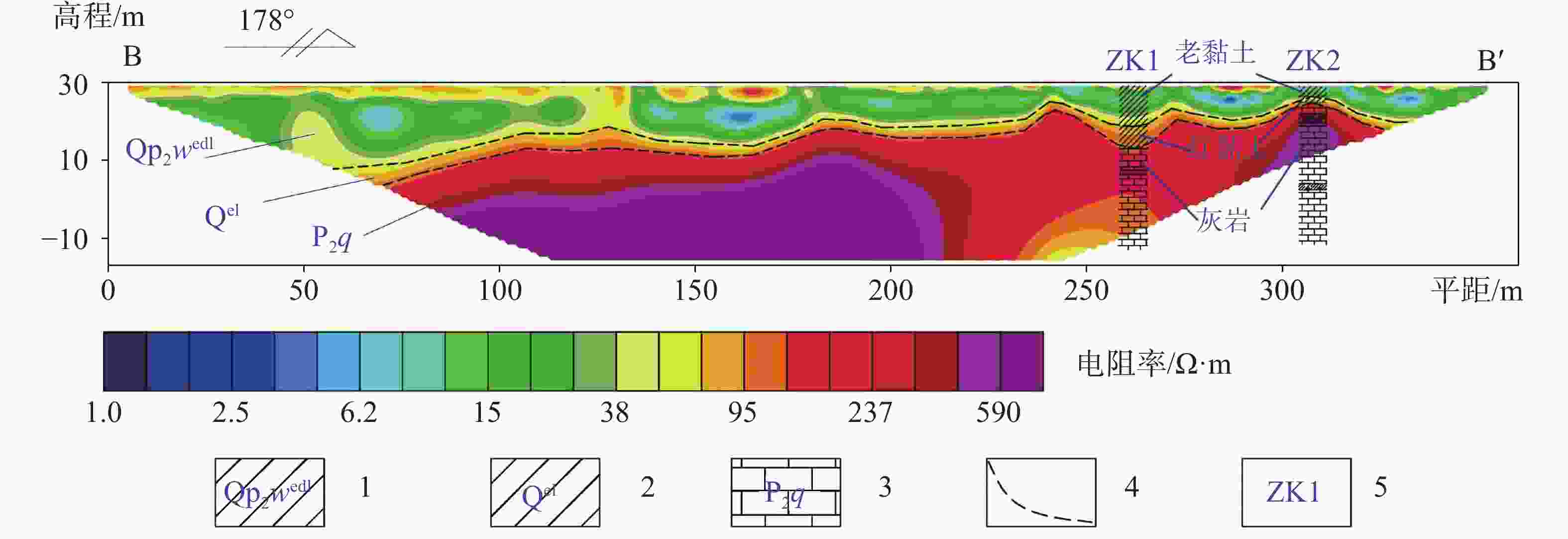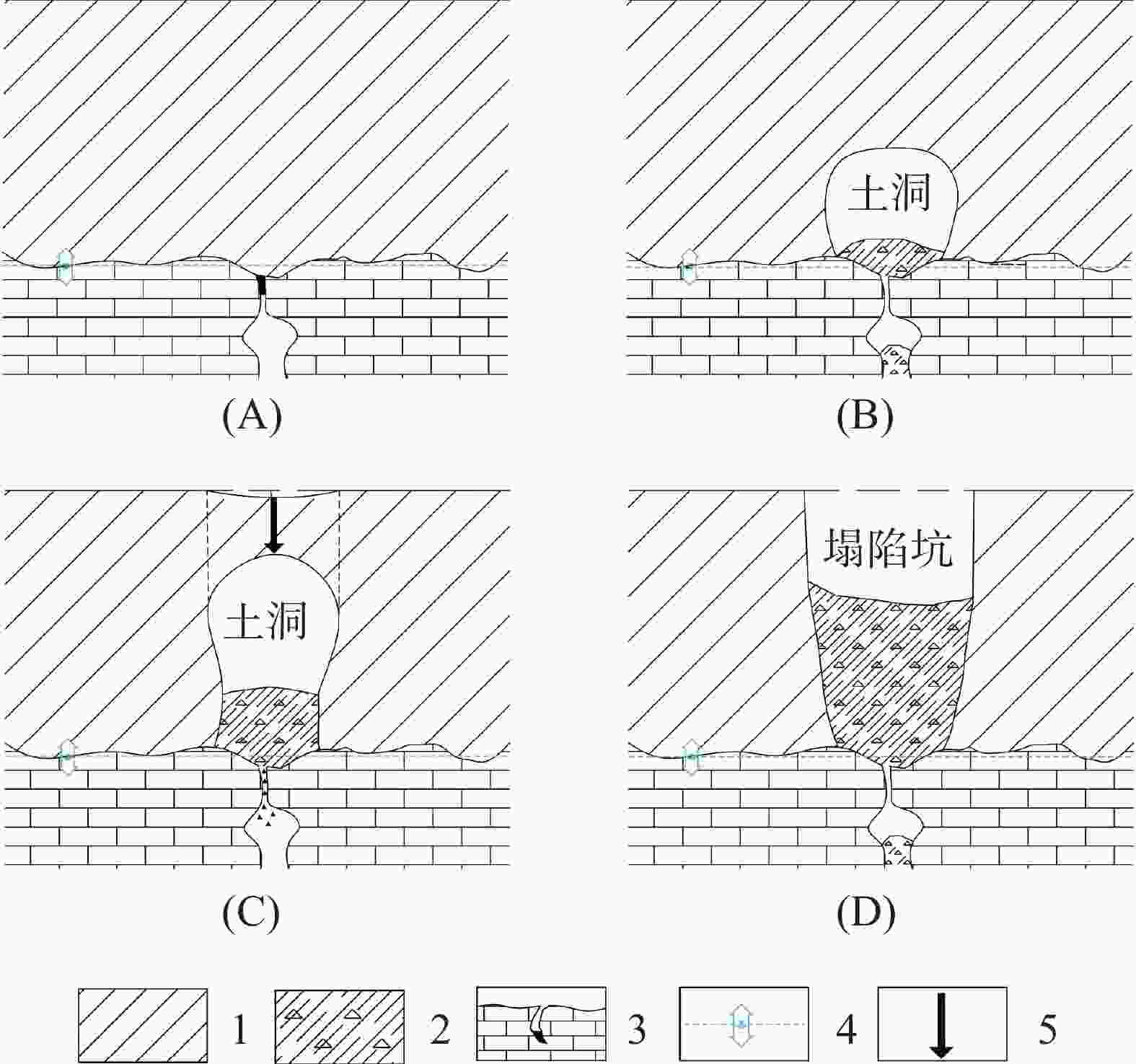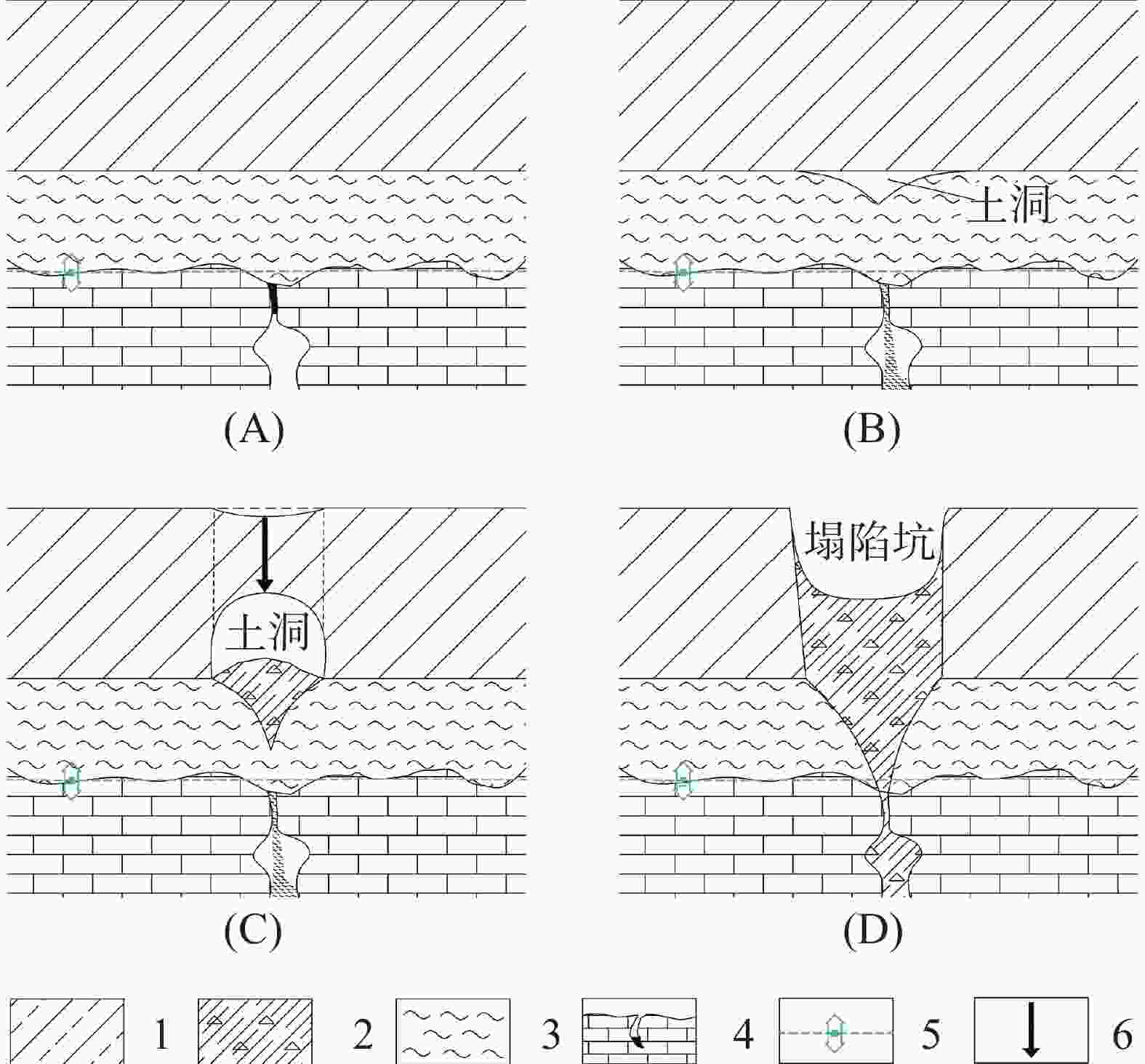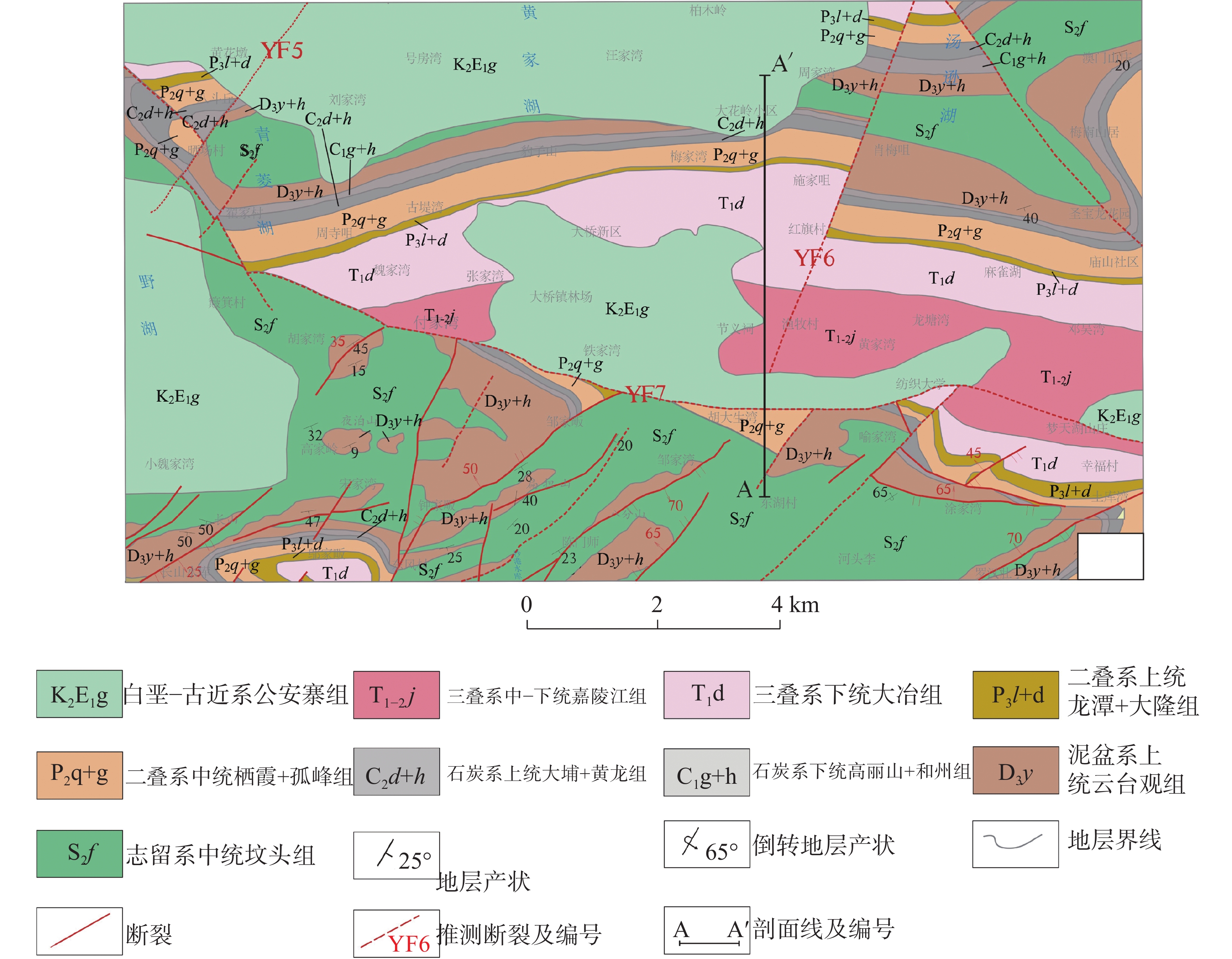Evolution and monitoring of karst ground collapse in the Zhifang-Miaoshan paleo-clay area of Wuhan
-
摘要: 为查明武汉纸坊−庙山一带老黏土区岩溶地面塌陷成灾机理,并选取合适方法手段进行监测预警,有效减轻岩溶地面塌陷造成的危害,通过岩溶专项调查,查明了区内可溶岩分布及其地质结构,分析了岩溶地面塌陷形成演化过程及不同塌陷阶段监测方法的选取,调查分析结果表明:该区多为单层结构老黏土分布区,根据盖层黏性土、软弱土、非可溶岩(红层)的上下组合关系,将可溶岩分布区地质结构划分为3类(①、②、③)。不同的地质结构根据土体物理力学特征差异,其发生岩溶地面塌陷的形成演化机理不同:①类结构主要发生土洞型塌陷,②类结构主要发生泥流+土洞复合型塌陷,③类结构由于红层的阻隔,黏性土土洞无法形成,一般不会产生塌陷。结合塌陷的演化过程,土洞的形成演化阶段,重点是采用光纤等技术监测土洞的形成扩展情况,同时也要对地下水位、水气压力等诱发因子进行监测;土洞顶板变形塌陷阶段,因临塌前地表往往会产生少量沉降变形,主要采用精密水准测量或GPS监测等技术监测地表形变。Abstract:
This study is aimed at finding out the disaster mechanism of karst ground collapse in the Zhifang-Miaoshan paleo-clay area of Wuhan and selecting appropriate methods for the monitoring and early warning, so as to effectively reduce the harm caused by karst ground collapse. Through a special karst survey, we have identified the distribution and geological structure of soluble rocks, analyzed the formation and evolution process of karst ground collapse and selected monitoring methods for different collapse stages in the study area. The survey results show that the study area is mostly distributed by paleo-clay with single-layered structure. According to the upper and lower stacking relationship of overburden cohesive soil, soft soil and non-soluble rock (red layer), the geological structure distribution of soluble rock can be divided into three categories (①, ② and ③). In the structure of class ①, the upper part is composed of cohesive soil; the lower part is soluble rock. The cohesive soil is mostly composed of paleo-clay with the value of cohesion C mainly from 42 kPa to 70 kPa, and the φ value mostly from 10.3° to 19.1°. The free movement of the soil particles is limited, and soil holes are usually formed at the bottom of the soil layer in the soil body. In the structure of class ②, the upper part is composed of cohesive soil; the middle part is soft soil (residual red clay in the shape of soft plastic-flow plastic); the lower part is composed of soluble rock, in which the red clay—weathering residues of the limestone surface—is prone to soften in the shape of soft-fluid plastic in water. Mainly distributed in solution grooves with uneven thicknesses, the red clay usually loses with the action of gravity or suction force, and hence is developed into soil holes. In the structure of class ③, the upper part is composed of cohesive soil; the middle part is the red layer (K2E1g red sandstone); the lower part is soluble rock. In this structure, soil holes are difficult to form due to the barrier of red layer; therefore, karst ground collapse is not likely to occur under the natural condition. According to the different physical and mechanical characteristics of soil bodies, the process mechanism of karst ground collapse is various in different geological structures. Soil-hole collapse mainly occurs in the structure of class ①.The disaster evolution process can be summarized as follows: (A) In the undisturbed stage, the karst water level drops little, and the small value of the suction negative pressure leads to the failure of soil denudation caused by insufficient suction force. Therefore, there is no significant change in the soil body. (B) Affected by the repeated fluctuations of karst groundwater level or human engineering activities, the soil hole is developed initially along the surface of the open karst cave, when the corrosion absorption force is greater than the collapse resistance force of the soil itself. Then the soil of the cave roof collapsed, and the continuous collapse upward contributes to the expanding of the soil hole and the thinning of its roof. (C) The hole continues to expand upwards, and the roof of the soil hole keeps balanced under the friction force generated by the lateral pressure of soil around it. In the early stage of imminent collapse, the ground surface often presents a small amount of subsidence deformation. (D) Induced by natural or man-made factors, the surrounding friction can not balance the gravity of the roof of soil hole. Consequently, the roof may collapse quickly. In the structure of class ②, there mainly occurs compound collapse of mud flow+soil hole. The process of disaster formation and evolution can be summarized as follows: (A) Thick layers of soft soil and cohesive soil are developed on the upper soluble rock. The karst opening is in the stable stage due to the blockage of the cohesive soil. (B) Affected by fluctuations of karst groundwater level or human engineering activities, the soft soil flows and loses to the cave fissure, which forms the mudflow hole, and the hole quickly expands to the top of the soft soil. (C) The soil hole continues to expand upward in the layer of cohesive soil, and the roof of the soil hole keeps balanced under the friction force generated by the lateral pressure of soil around it. In the early stage of imminent collapse, the ground surface often presents a small amount of subsidence deformation. (D) Induced by natural or man-made factors, the surrounding friction can not balance the roof of soil hole (dead weight+loading); consequently, the roof collapsed quickly. Besides, the quick loss of red clay in shapes of soft plastic-fluid plastic accelerates karst ground collapse. In the structure of class ③, it is unlikely to occur collapse because the barrier of red layer makes it difficult to form the cohesive soil. Combined with the formation mechanism of collapse, the formation and evolution of soil hole can be monitored by optical fiber, and induced factors such as groundwater levels and water pressures should also be monitored. During the deformation and collapse stage, precise leveling or GPS monitoring can be used to monitor surface deformation because the ground surface often presents a small amount of subsidence deformation before the imminent collapse. -
表 1 研究区岩溶区地质结构类型划分
Table 1. Classification of karst geological structures of the study area
类型 模型图 结构特点 主要分布 ① 
黏性土直接覆盖于可溶岩上;可发生土洞型塌陷 工作区西北角洪山区八斗丘,多属一级阶地后缘;中部纸坊翟家村—周寺咀—魏家湾—张家湾、节义祠—黄家湾—龙塘湾、东南角梦天湖山庄—土库湾—半甲杨、西南角,多属长江二级阶地剥蚀垄岗区 ② 
黏性土和可溶岩之间夹有厚度大于1 m的软弱土(红黏土底部);软塑−流塑红黏土先期流失形成泥流型土洞,逐渐发展破坏,地表反映为土洞型塌陷 工作区中部纸坊古堤湾—豹子山—红旗村—往南至渔牧村;多属于长江二级阶地剥蚀垄岗区 ③ 
黏性土+红层直接覆盖于可溶岩上;一般不会发生岩溶地面塌陷 工作区中部纸坊大桥镇林场—铁家湾—纺织大学;属于长江二级阶地剥蚀垄岗区 表 2 研究区岩溶地面塌陷类型分类表
Table 2. Classification of karst ground collapse in and around the study area
序号 发生时间 塌陷名称(地点) 塌陷规模 塌陷灾情 地质结构 诱发因素 塌陷机理 1 2014.5.2 江夏区大桥新区鹏湖湾二期工地 中型 二人死亡,一台钻机失踪。后期搜救动用10台挖掘和运输车辆,清土方8 000多方,动用大量人力,包括武警水电部队 ② 钻探、载荷 泥流+土洞
复合型2 2016.2.25 江夏区原武汉东方明浒混凝土场有限公司厂区 小型 毁坏厂房地面,造成混凝土厂暂停营业 ② 载重车辆荷载 泥流+土洞
复合型 -
[1] 徐卫国, 赵桂荣. 论岩溶塌陷形成机理[J]. 煤炭学报, 1986(2):1-11. doi: 10.13225/j.cnki.jccs.1986.02.001XU Weiguo, ZHAO Guirong. On the mechanism of karst collapse formation[J]. Journal of China Coal Society, 1986(2):1-11. doi: 10.13225/j.cnki.jccs.1986.02.001 [2] 康彦仁. 论岩溶塌陷形成的致塌模式[J]. 水文地质工程地质, 1992(4):32-34, 46. doi: 10.16030/j.cnki.issn.1000-3665.1992.04.014KANG Yanren. On the collapse-causing mode of karst collapse formation[J]. Hydrogeology & Engineering Geology, 1992(4):32-34, 46. doi: 10.16030/j.cnki.issn.1000-3665.1992.04.014 [3] 罗小杰, 罗程. 岩溶地面塌陷三机理理论及其应用[J]. 中国岩溶, 2021, 40(2):171-188.LUO Xiaojie, LUO Cheng. Three-Mechanism Theory (TMT) of karst ground collapse and its application[J]. Carsologica Sinica, 2021, 40(2):171-188. [4] 王金晨, 吴迪, 娄万鹏, 吴远斌. 岩溶塌陷监测技术及发展趋势[J]. 工程技术研究, 2021, 6(8):55-57. doi: 10.3969/j.issn.1671-3818.2021.08.023WANG Jinchen, WU Di, LOU Wanpeng, WU Yuanbin. Karst collapse monitoring technology and development trend[J]. Engineering and Technological Research, 2021, 6(8):55-57. doi: 10.3969/j.issn.1671-3818.2021.08.023 [5] 李成香, 刘磊, 周世昌, 王斌战. 物探技术在岩溶塌陷灾害监测预警中的应用研究[J]. 资源环境与工程, 2021, 35(6):887-894. doi: 10.16536/j.cnki.issn.1671-1211.2021.06.020LI Chengxiang, LIU Lei, ZHOU Shichang, WANG Binzhan. Application of geophysical prospecting technology in karst collapse disaster monitoring and early warning[J]. Resources Environment & Engineering, 2021, 35(6):887-894. doi: 10.16536/j.cnki.issn.1671-1211.2021.06.020 [6] 蒋小珍, 雷明堂. 岩溶塌陷灾害的岩溶地下水气压力监测技术及应用[J]. 中国岩溶, 2018, 37(5):786-791.JIANG Xiaozhen, LEI Mingtang. Monitoring technique and its application of karst groundwater-air pressure in karst collapse[J]. Carsologica Sinica, 2018, 37(5):786-791. [7] 王甫强, 张占彪, 李虎, 柯洋. 光纤传感技术在岩溶地面塌陷地质灾害监测中的应用[J]. 城市勘测, 2021(4):174-178. doi: 10.3969/j.issn.1672-8262.2021.04.041WANG Fuqiang, ZHANG Zhanbiao, LI Hu, KE Yang. Application of optical fiber sensing technology in geological hazard monitoring of karst ground collapse[J]. Urban Geotechnical Investigation & Surveying, 2021(4):174-178. doi: 10.3969/j.issn.1672-8262.2021.04.041 [8] 陈标典, 李喜, 李祖春, 等. 湖北武汉白沙洲隐伏岩溶区地质结构与岩溶塌陷分类[J]. 中国地质灾害与防治学报. 2021, 32(2): 43-52.CHEN Biaodian, LI Xi, LI Zuchun, et al. Types of geological structures and mechanism of karst collapses in Baishazhou, Wuhan City of Hubei Province [J]. The Chinese Journal of Geological Hazard and Control, 2021, 32(2): 43-52. [9] 涂婧, 李慧娟, 彭慧, 魏熊, 贾龙. 武汉市江夏区大桥新区红旗村黏土盖层岩溶塌陷致塌模式分析[J]. 中国岩溶, 2018, 37(1):112-119.TU Jing, LI Huijuan, PENG Hui, WEI Xiong, JIA Long. Analysis on collapse model of the karst area covered by clay in Wuhan City Jiangxia district Hongqi village[J]. Carsologica Sinica, 2018, 37(1):112-119. [10] Li Gang, Tan Jinghe, An Ning. Analysis of the cause of karst land collapse in siding lead-zinc mining area[J]. Applied Mechanics and Materials, 2013, 368-370: 1606-1609. [11] 郑晓明, 陈标典, 潘峰, 等. 武汉市江夏区武嘉高速桩基施工岩溶塌陷形成条件及机理研究[J]. 安全与环境工程. 2019, 26(2): 62-68+75.ZHENG Xiaoming, CHEN Biaodian, PAN Feng, et al. Formation conditions and mechanism of karst collapse during pile foundation construction of Wujia Highway in Jiangxia district, Wuhan[J]. Safety and Environmental Engineering. 2019, 26(2): 62-68+75. [12] Xu Zhimin, Sun Yajun, Gao Shang, Chen Hongying, Yao Minghao, Li Xin. Comprehensive exploration, safety evaluation and grouting of karst collapse columns in the Yangjian coalmine of the Shanxi Province, China[J]. Carbonates and Evaporites, 2021, 36(1): 1-12. [13] 覃剑文, 宋光啸, 潘光明. 城区复杂环境岩溶地面塌陷灾害成因与致灾规律研究: 以贵港市北环新村岩溶地面塌陷灾害为例[J]. 中国岩溶, 2021, 40(2):230-237.QIN Jianwen, SONG Guangxiao, PAN Guangming. Cause and law of karst collapse in the urban complex environment: An example of Beihuanxincun, Guigang City[J]. Carsologica Sinica, 2021, 40(2):230-237. [14] 吴远斌, 殷仁朝, 雷明堂, 戴建玲, 贾龙, 潘宗源, 马骁, 周富彪. 重庆中梁山地区隧道工程影响下岩溶塌陷形成演化模式及防治对策[J]. 中国岩溶, 2021, 40(2):246-252.WU Yuanbin, YIN Renchao, LEI Mingtang, DAI Jianling, JIA Long, PAN Zongyuan, MA Xiao, ZHOU Fubiao. Triggering factors and prevention-control countermeasures of karst collapses caused by tunnel construction in the Zhongliangshan area, Chongqing[J]. Carsologica Sinica, 2021, 40(2):246-252. -




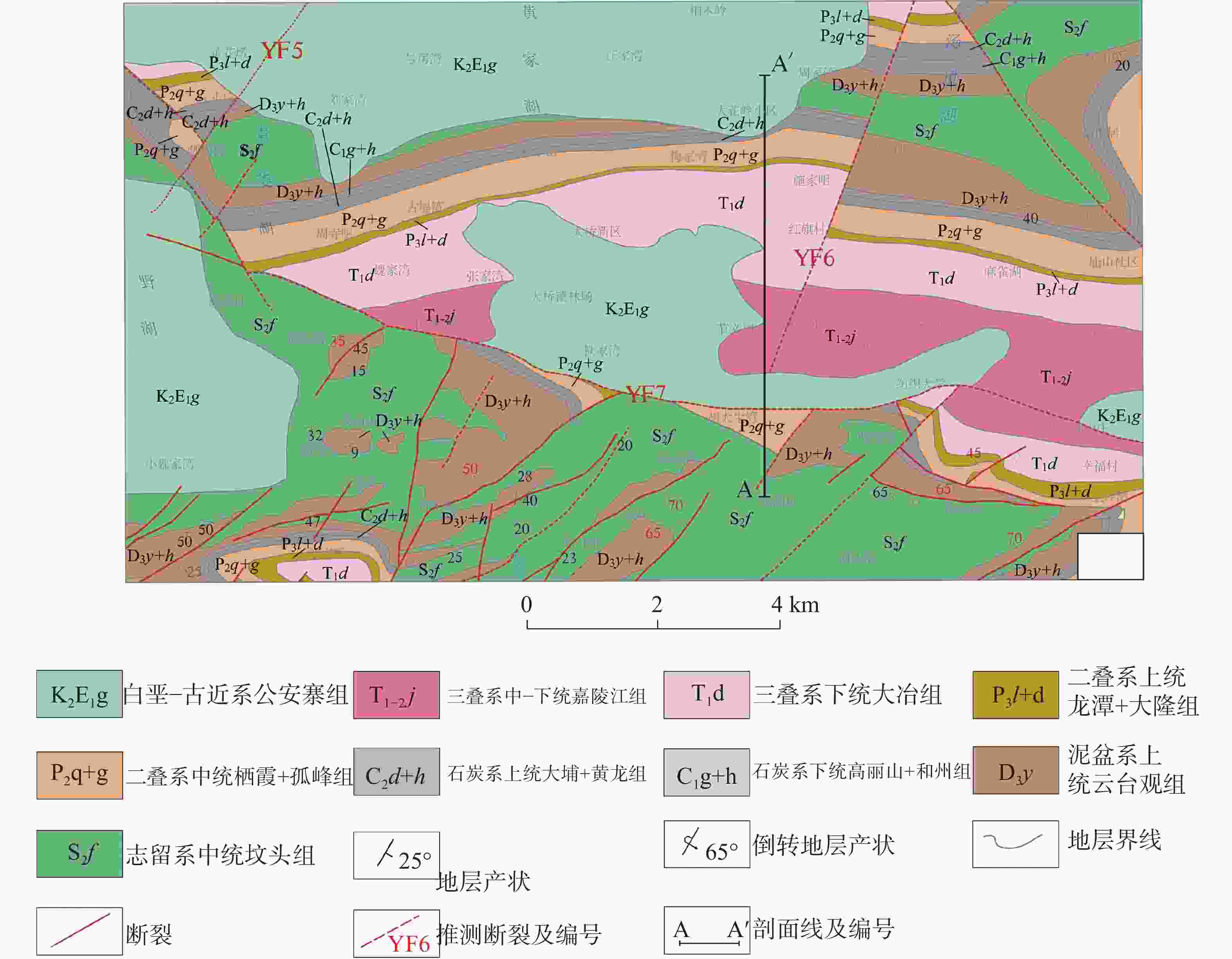
 下载:
下载:

